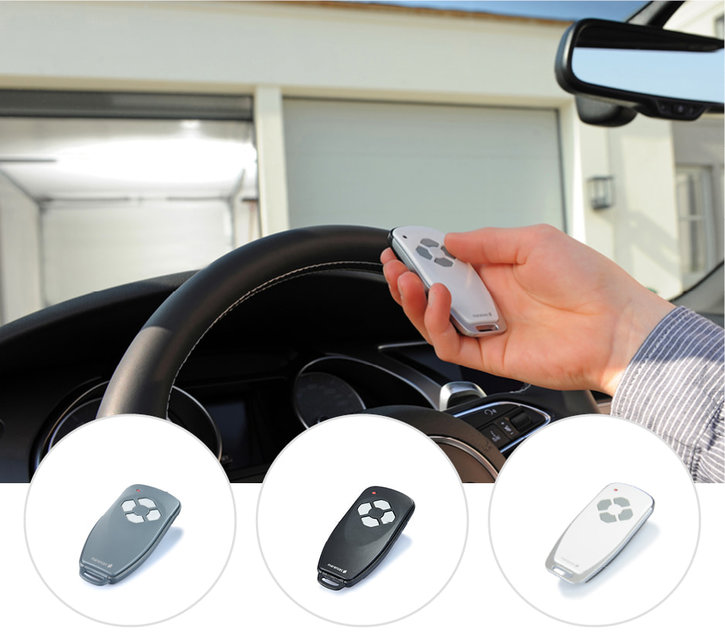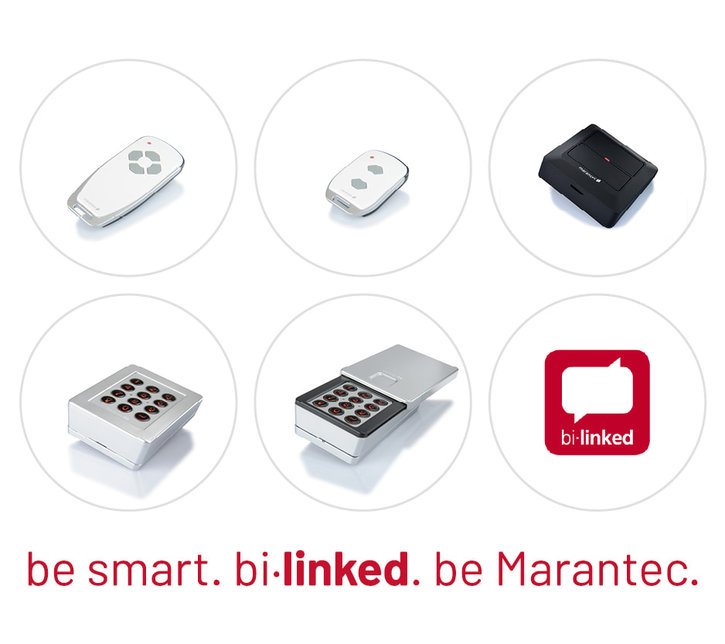
bi·linked is our wireless standard which sets the benchmark. It is used in all our wireless handheld transmitters and wireless accessory products. bi·linked was developed by our experienced engineers and is produced in our own facilities.
Multi-Bit is a proven wireless system with 48-bit encryption. It is unidirectional, which means that communication only takes place in one direction: The handheld transmitter sends out a command, the opener executes it and opens the door, for example.
DM7S Brand-new and highly secure: This wireless system was developed by Marantec for the management of larger installations. DM7S is used in our new Digital 702 and 704 handheld transmitters.
Based on the wireless system, handheld transmitters and compatible antennas are available. In this overview, we have listed both for you. They are sorted according to the wireless standard which the handheld transmitters use: bi·linked, Multi-Bit or DM7S. Furthermore, we also explain to you which Marantec openers with which handheld transmitters are compatible with the HomeLink system in your car.
Handheld transmitters:
Receiver/antenna:
Handheld transmitters:
Receiver/antenna:
Handheld transmitters:
Receiver/antenna:
Marantec openers which operate using the Multi-Bit wireless system in combination with one of the following handheld transmitters are compatible with the HomeLink system:
| Handheld transmitter | Frequency (MHz) | Code type | Information |
|---|---|---|---|
| Digital 101 | 27.045 | Fixed code | |
| Digital 211 | 433.92 | Fixed code | |
| Digital 212 | 433.92 | Fixed code | |
| Digital 214 | 433.92 | Fixed code | |
| Digital 302 | 433.92 | Fixed code | |
| Digital 304 | 433.92 | Fixed code | |
| Digital 313 | 433.92 | Fixed code | |
| Digital 302 | 868.3 | Fixed code | Compatible with HomeLink Software Version 7 and above |
| Digital 304 | 868.3 | Fixed code | Compatible with HomeLink Software Version 7 and above |
| Digital 313 | 868.3 | Fixed code | Compatible with HomeLink Software Version 7 and above |
The method for connecting your opener to your car via HomeLink varies depending on the vehicle and is described in detail at www.homelink.com.
Distance between opener and remote: The range of the wireless system depends on the mounting location of the opener and the remote, and can vary depending on the installation. For optimum range, position the opener and the remote such that the shortest communication distance, i.e., as the crow flies, passes as little as possible through masonry or other materials that weaken the signal.
Radio signals are weakened by various factors: The type and nature of the materials through which the wireless devices need to communicate play an important role.
The higher the percentage value in the table and hence the range, the further away you can be located when operating your door or gate. However, please note one thing: For reasons of safety and security, you should only operate your door or gate when you are able to see it.
| Material | Range |
|---|---|
| Air, open spaces | 100 % |
| Wood, plaster | 80 to 95 % |
| Uncoated glass | 70 to 90 % |
| Brick, concrete | 60 to 90 % |
| Metal-coated glass (e.g. insulating glass) | 10 to 60 % |
| Reinforced concrete | 10 to 50 % |
| Vehicle body | 10 to 40 % |
| Metal walls, metal mesh | 0 to 10 % |
In order to achieve an optimal range for your wireless system and thus be able to operate your doors and gates from a greater distance, you should observe a few tips during installation: Avoid unnecessary metal shielding, such as cabinets or housings. Also ensure as much distance as possible from live wires and equipment such as lamps or machines. Other possible sources of interference which could limit the range include:
Keep a distance from these sources of interference, or ideally, ensure that they are nowhere near your opener. The thermal insulation glazing of your car may also influence the range. The lowest absorption occurs at the height of the A pillar, i.e. to the left and right of the windscreen.
If you are experiencing problems with the range, we recommend the use of an external rod antenna.: It significantly improves the range of the handheld transmitter and the opener. Our accessory products can be obtained from your specialist Marantec retailer.
No. The wireless products emit practically no radiation that is harmful to the health of humans and animals. Also with regard to pacemakers or hearing aids, there are no known possible problems which are caused by our wireless products.
One important factor for this is the fact that our products operate using extremely low transmission levels (less than 10 mW) and transmissions always take place only over a very short period of time, in the millisecond range. For comparison: A cell phone transmits at much higher levels (up to 1,000 mW), and also over a much longer period of time.
You can also be assured that your Marantec radio system is not harmful to your health because all radio products placed on the market by Marantec meet the essential requirements of the European R&TTE Directive 1999/5/EC, implemented in Germany via the Radio and Telecommunications Equipment Act (FTEG). In addition to compliance with all the relevant standards relating to radio wave propagation and electrical safety, this also includes compliance with the relevant standards for electromagnetic compatibility (EMC) and for the safety of persons in electromagnetic fields (EMF).

bi·linked is our wireless standard which is used in all our wireless handheld transmitters and wireless accessory products. bi·linked was developed by our experienced engineers and is produced in our own facilities.

Wireless technology is used for numerous applications worldwide. It makes it easy and convenient to operate a wide range of electrical devices. The press of a button is all it takes. Convenience is something all wireless systems offer. But it is also important to know how secure this convenience is. The differences here are great.
Apart from convenience, our primary focus is on security when developing our products. Hence, our bi·linked wireless technology operates using 128-bit encryption, which is also used e.g. in online banking. At the same time, it operates with a rolling code, i.e. the code generated at the push of a button changes each time, such that copying or decoding the signal becomes almost impossible. The technology is known exclusively to our engineers and we also produce all our bi·linked wireless products at in-house facilities. Together, all these aspects form the basis for one of the most secure and convenient door and gate openers worldwide. Compare us.
Multi-Bit is a proven and highly secure wireless system that Marantec developed for controlling openers. The signals from the handheld transmitters, keypads etc. to the opener are transmitted reliably with 48-bit encryption.
The use of a total of approx. 70 million different transmission codes ensures extra high security – each opener uses a different code. For example, if a handheld transmitter is lost, a new code can easily be programmed for all other units. This way, if a stranger finds it, the lost handheld transmitter no longer works.
Multi-Bit is a unidirectional wireless system, which means that communication only works in one direction: The handheld transmitter sends out a command, the opener executes it and opens the door, for example.
DM7S is the latest and a highly secure wireless system developed by Marantec for the management of larger installations. DM7S is used in our new Digital 702 and 704 handheld transmitters.
The wireless transmission is highly secure thanks to 128-bit encryption in accordance with the AES standard – this is also used, for example, in online banking or encrypted https pages such as for order processes. The code transmitted during use is different for each keystroke, which makes copying or decrypting the radio signal almost impossible.
The advantage of this wireless system is the simple and convenient management of a large number of handheld transmitters. The individual serial number on the rear of the handheld transmitters allows them to be managed using the Windows software. If a handheld transmitter is lost, a new replacement handheld transmitter can be assigned with the use of the software and a programming device. Without any special programming expertise for the receiver or the gate control, the pre-programmed handheld transmitter can be used immediately by the user after pressing any button within range of the gate system 2 times.
Would you like more information about DM7S? Click here for detailed information on our handheld transmitter management.
DM7S handheld transmitter management